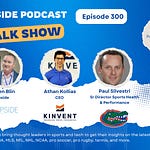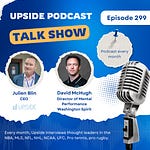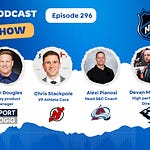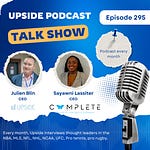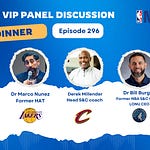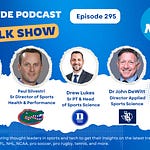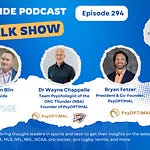Today we have the honor to interview James Mayo, Founder of Sm24, a non invasive real time biomarker analysis sensor company.
Sm24 is a device that can give the user the ability to track: recovery, pace, glucose, carb / fat burn and further down the line other biomarkers. So in short helping them train optimally. Sm24 can be seamlessly integrated into other AI systems of teams or into Strava, Apple health, Garmin, Fitbit. It adds the extra dimension to a user’s data
Sm24 is non invasive and provide data in real-time continuously. Sm24 is agnostic to the position on the body. This means the user can forget they are wearing it.
Here is a picture of Sm24 product:
Here is a video that explains how the technology works, how it is different from other products out there and what the benefits for teams are:
📝Show Notes: Through this interview, we touched on his background, and his company and product. We also discussed the benefits for sports organizations and athletes to use his product. Lastly we talked about his competitive advantage, business model and plans for the next 12 months.
Best Quotes: Here’s some of the key discussion points and best quotes from our conversation with James:
On his background:
“I was a pro athlete. I ran track 800 meters professionally for several years. Also my family was in the military for generations and I joined the infantry as an officer. I spent six years in the army, which was amazing and I really enjoyed it, but there were a couple of things I learned from pro athletes and the military”.
“It is that I wish I'd have been able to understand my biomarkers from a training perspective such as my hydration glucose lactic, and move that forward. Now when I left the army, I ended up in Singapore, where I worked for ESPN Star Sports as one of their journalists, sportscasters. But more importantly, I was employed by the Singapore Amateur Athletics Association to be their distance coach”.
“Singapore is a very hot and a very sweaty place. Distance athletes are not particularly pretty. And part of that was also helping out the training program for the Singapore marathon. So it required a wide ranging skill set, but I learned an awful lot about dehydration, the sports physiology side of life. And then I left there and moved back to the UK, where I joined a recruitment firm called Michael Page, where I moved around with them for several years. And then when we were in San Francisco with my wife and my brother we came up with the idea for an hydration drink, which is now SOS that you can find in all the CVSs”.
On how he got the idea of building the Sm24 sensor:
“There are various sweat monitors out there who are doing a cracking job, mainly in the hydration space, but their modus operandi is to pull sweat and then measure it once they've got a sort of a bucket full. And that to me was great for what they're using it for. But from my perspective, I wanted to look at glucose. I wanted to look at lactic, and then hydration or another biomarkers”.
“Later, the key goal was that I didn't want people to have to be sweating profusely for it to work. And the second one is I needed some form of accuracy to blood. And my co founder Coralie, who joined me with this adventure, is a rock star. She has 30 years of sensing experience. She's really the brains behind this and it has been supported by the Imperial College in London”.
On their Sm24 sensor:
“What we've got to is a stage where we have a sensor that uses electrochemical sensing to basic chemical sensing to measure as it comes out the pores, basically your sweat and it can find glucose within milliseconds of it coming out”.
“From a glucose monitoring perspective, if you need to fuel, if you're 20 minutes behind, you're already cooked. Same with operation. Same with the lactic. If you look at the Tour de France cyclists, you see them going up some mountains and as soon as they go past their red line, they're in a mess”.
“Now, imagine, and this is where our focus from Sm24 is, imagine the fact that I could tell you when to fuel, when to hydrate, what pace to train at, when to burn carbs, when to burn fat, and more importantly, the one that no one really talks about but is the most important is the recovery angle”.
If you use a Lactate, you can understand the Lactate. Now, there are Lactate monitors out there. For us, it's all based off a an algorithm off your heart rather than an exact science. So we've got to the stage where our prototype is now finished. We've worked out the algorithm to convert sweat glucose to blood glucose and as you said we are correlating beautifully to blood. We are 20 minutes quicker and we've got multiple patterns on the device”.
On the fact that their sensor is able to measure glucose and lactic acid levels and will be able to measure cortisol level in the future:
“So this next phase is finishing the manufacture product, taking it then through. We already have various teams on board. Again, I can't mention the teams at the moment but we will start testing our product on those teams. But more importantly, we can give them that data because they've got how far they're running, they've got their GPS data, they've got their movement data, but they don't have the core two, and it'll be glucose and lactic that we start with first and we'll add other biomarkers later, maybe cortisol from a stress perspective”.
On their business model:
“Our business model is very much B2B. We don't plan on going direct to the consumer as in individual user. We plan on working hard with the teams and the military. The health systems of this world would love to have something like this as well. As you move through the early adopters of sports to the health care systems and everything else to give patients that access”.
“And we also know that many of the large health sport tech organizations would like some form of ability to measure those biomarkers. So it's a B2B model that we're focusing on”.
On the size of their Sm24 sensor and the fact that users can put the sensors in various locations:
“The sensor is not much bigger than a pen tip, and the actual patch or band will be no bigger than the current interstitial bands, microneedle band patches that are out there. So think of something that could fit on a watch, or something like that, or as a basically band aid with the sensor embedded into it”.
“Then you would be able to put the sensor on the wrist, or on the chest. If you want to wear it on your forehead, you can wear it on your forehead. But you can put our sensor on your forehead, arm, back, or anywhere on the body. So you're not constrained like many things to certain areas”.
“And we certainly see from certain games, those that require that athletes are hitting, catching, striking something where the arm is everything. If you've got some form of filament in your arm, that's a distraction. So therefore with Sm24, you won't need to wear it on your arm if you don't want to. And there's no preferred location on the body in particular”.
On the fact that the Sm24 sensor can be worn for a couple of weeks and is reusable unlike other hydration patches that are single use only:
“You can wear it for a couple of weeks. One of the issues with some of the other like hydration patches is that it's single use only. And this is again, that's because it's filling up that bucket of sweat. The beauty with ours is that we measure sweat, but it's just in a different way”.
“And the adventure is that it's not when the sensor stops working after a couple of weeks or whatever, it just stops working. So you can wear it full time if you want, or depending on how it is, you can just put it on, take it off, put it back on again. And it takes about a minute to get a reading.”.
On the benefits for teams to use their sensor and the use cases:
“So first is fueling. When an athlete is going into a game, post game or during a game… If you can understand where your glucose levels are, then you've got something. So that's the first one”.
“The second one is the lactic side of life. Lactic tells you your pace, and if you're into the VO2 max. So if you are screaming out of your eyes and you are about to collapse you are looking to use it to recover or in some cases burn fat or burn carbs”.
“And then you've got other biomarkers. You can look at the biggest advantages are that it doesn't take an hour before it works. So you can just put it on the second one is it's not invasive”.
“The third one is that it's correlates to blood which means that you're not trying to do some back calculation. The fourth one is that it doesn't need to be anywhere on the body. And the fifth one is that these interstitial patches at the moment, these microneedles at the moment, can't measure lactic and other biomarkers”.
“The beautiful thing about Sm24 is that we can measure other biomarkers and we've already seen it in our testing. So we bring that into rather than a current team having to buy a hydration sensor, a glucose monitor and get lactic testing, which used to be in the year. They could just go to Sm24 and our sensor has everything all in one area of the space. It's like a Swiss Army knife. We have all the biomarkers into one”.
“Now we're not going to rush all of them. Lactic and glucose are the two sensors that we are starting with. But that's from a team's perspective. That's great. And they're small, they travel, you can recharge the batteries. So it's a nice, simple. I think the goal is just keeping it simple”.
On the future of availability of its product:
“In terms of availability, once we finish our funding round, we're about nine months away from getting the finished product into teams and getting them to start to use it. And then after that, you're probably a year to 18 months from being able to start selling it”.
On their plans for the next 12 months:
“In the next 12 months, obviously we plan to complete the fundraising and then build the final product for sale. That gives us the opportunity to have thousands of them to put onto teams to get it moving and start all about the data coming back to where we came from with SOS is and where we're still going with SOS is The more proof points and touch points you have, the better the trust factor is”.
“And our plan is to work with pro teams. And for the first couple of teams that we'll be working with, it's super exciting because they get to learn from us. We get to learn from them. They get advantage over their competition and we build long lasting relationships with teams to sort of take it forward”.
The nice thing with our algorithm is that it correlates to blood. People know what to do with their blood glucose or their blood lactate. So by us giving them that number, they've got the answers to that piece. We can give them as an example from the blood lactic. They'll be able to calculate their five black stones or six, depending on where you come from. And the same with the blood glucose, you'll know where you are and so on and so forth”.
You may also like:
💦Upside Analysis: The sweat and heat sensing market (Key Trends, Vendors)
With the Australian Open Tennis fast approaching (Jan 17-30) where pro tennis athletes will have to play under very hot conditions we thought it was a good idea to republish our sweat and heat sensing analysis. Of note we added some new hydration assessment vendors (Flowbio, Intake.health) in this analysis.
🔥 Upside Chat: Dave Hancock, CEO, Apollo (Leading Athlete Management Systems (AMS) vendor)
🔥 Upside Chat: Dr Andy Barr, Consultant, Brooklyn Nets (NBA) & Quantum Performance Founder






